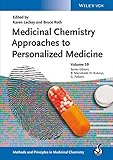Medicinal chemistry approaches to personalized medicine / edited by Karen Lackey and Bruce D. Roth.
Material type: TextSeries: Medicinal chemistry ; Volume 59.Publication details: Weinheim : Wiley-VCH, 2014.Description: 1 online resourceContent type:
TextSeries: Medicinal chemistry ; Volume 59.Publication details: Weinheim : Wiley-VCH, 2014.Description: 1 online resourceContent type: - text
- computer
- online resource
- 9783527677283
- 3527677283
- 9783527677252
- 3527677259
- 1306168902
- 9781306168908
- 9783527333943
- 3527333940
- 9783527677269
- 3527677267
- 9783527677276
- 3527677275
- 615.1/9 23
- RS403
- RM111 .L384 2013
- QV 744
Includes bibliographical references and index.
Print version record.
Methods and Principles in Medicinal Chemistry; Title Page; Copyright; List of Contributors; Foreword; Preface; A Personal Foreword; Acronyms; Chapter 1: Medicinal Chemistry Approaches to Creating Targeted Medicines; 1.1 Introduction; 1.2 Role of Medicinal Chemistry in Drug Discovery; 1.3 Evolution of Molecular Design for Subsets of Patients; 1.4 Combinations for Effective Therapies; 1.5 Biomarkers in Targeting Patients; 1.6 Emerging Field of Epigenetics; 1.7 Systems Chemical Biology; 1.8 Theranostics and Designing Drug Delivery Systems
1.9 Rapid Progress in Further Personalizing Medicine ExpectedReferences; Chapter 2: Discovery of Predictive Biomarkers for Anticancer Drugs; 2.1 Introduction; 2.2 "Oncogene Addiction" as a Paradigm for Clinical Implementation of Predictive Biomarkers; 2.3 Cancer Cell Lines as a Model System for Discovery of Predictive Biomarkers; 2.4 Modeling Drug Resistance to Discover Predictive Biomarkers; 2.5 Discovery of Predictive Biomarkers in the Context of Treatment Combinations; 2.6 Discovery of Predictive Biomarkers for Antiangiogenic Agents; 2.7 Gene Expression Signatures as Predictive Biomarkers
2.8 Current Challenges in Discovering Predictive Biomarkers2.9 Future Perspective; References; Chapter 3: Crizotinib; 3.1 Introduction; 3.2 Discovery of Crizotinib ( PF -02341066) [40]; 3.3 Kinase Selectivity of Crizotinib; 3.4 Pharmacology of Crizotinib [45,46]; 3.5 Human Clinical Efficacies of Crizotinib; 3.6 Summary; References; Chapter 4: Discovery and Development of Vemurafenib: First-in-Class Inhibitor of Mutant BRAF for the Treatment of Cancer; 4.1 Background; 4.2 Discovery and Development of Vemurafenib (PLX4032); 4.3 Pharmacology; 4.4 Clinical Efficacy and Safety
4.5 Companion Diagnostic (cobas 4800) Development4.6 Synthesis; 4.7 Summary; References; Chapter 5: Targeting Basal-Cell Carcinoma: Discovery and Development of Vismodegib ( GDC -0449), a First-in-Class Inhibitor of the Hedgehog Pathway; 5.1 Introduction; 5.2 Hedgehog and Basal-Cell Carcinoma; 5.3 Cyclopamine as an SMO Antagonist; 5.4 Small-Molecule Inhibitors of SMO; 5.5 Preclinical Characterization of Vismodegib; 5.6 Vismodegib Clinical Experience in Phase I; References; Chapter 6: G-Quadruplexes as Therapeutic Targets in Cancer; 6.1 Introduction; 6.2 Quadruplex Fundamentals
6.3 Genomic Quadruplexes6.4 Quadruplexes in Human Telomeres; 6.5 Quadruplexes as Anticancer Targets -- Evidence from In Vivo Studies; 6.6 Native Quadruplex Structures; 6.7 Quadruplex-Small-Molecule Structures; 6.8 Developing Superior Quadruplex-Binding Ligands; 6.9 Conclusions; References; Chapter 7: Identifying Actionable Targets in Cancer Patients; 7.1 Introduction and Background; 7.2 Overview of Genomic Sequencing and Its Impact on the Identification of Actionable Mutations; 7.3 Actionable Targets by Clinical Molecular Profiling: the OICR / PMH Experience
Life Sciences
